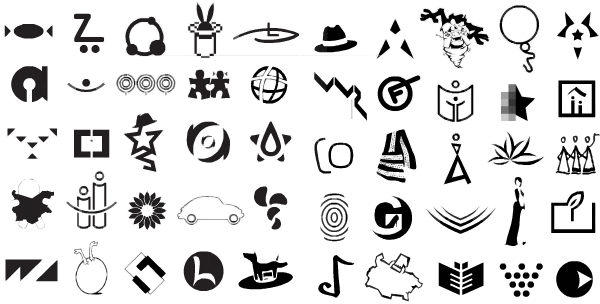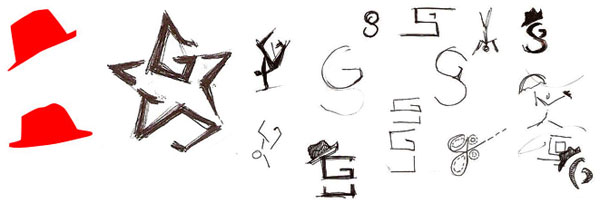Designing a logo is a process that combines a thorough understanding of the essence of the client’s message. When a designer sends the message utilizing multiple images within a unique single image — we call that a “world class logo”

We ran across this collection of logos while working on the Negative Space articles and just had to visit. Several of the logos grabbed our attention and we inquired about featuring them in the Design Center.
Margarit Ralev is the creative genius behind Ralev.com, a brand design studio, where he and Alex Ivanova apply their skils for clients around the globe. They feature the development of brands, and back it with the ability to make it happen in print, web or video. Margarit agreed to provide some insights into a few of the great logos in the Ralev portfolio. There are more, but here are the first few …

The name WalkTec comes from “walking technology” which represents progress technology. Margarit started literally from scratch with little to no prompting from the client.

Margarit writes:
This is how I designed the logo that taught me to think more about complete graphic solutions when searching the right shape for a single logo. In my thoughts the mark should be some kind of element that could be interpreted free in a pattern and in other various design cases. Something like a graphic “brick” with which you can build your full corporate identity.
The base is the triangle — a simple graphic primitive that allows infinite number of variations of different compositions. What is most interesting in this configuration is how the negative space plays into the mark, utilizing the triangles, to form the suggestion of the “W”
 The locked G of Galant and the not so hidden shoe.
The locked G of Galant and the not so hidden shoe.
For this client, a small shoe company from Sofia, Bulgaria Ralev developed the “G” and then cleverly constructed a portion of the letter as an image of the company’s product — shoes. To further push the negative space, the G was moved out, past the circle allowing the white field to flow into the negative space calling attention to the show. This is a brilliant solution — even though so nicely simple.
Margarit comments:
“They were using a only a logotype in Comic Sans ?! The moment I saw it I had to explaine to them the idea of having a real logo. I made it a circle so that it could be integrated easier in a lot of places. At that time I was more fan of very literal design, so a small shoe found its place in the center of the composition. The logo is printed over the shoe boxes in fairly large scale, so that you can clearly see the shoe in the logo”
The fact that the client hasn’t changed the logo since it was designed in 2003 is good proof that it’s working fine — something every logo designer hopes for.

This logo was for a young talent in Britan’s dancing scene. The logo sort of suggests the staccato, stack and tumble nature of ‘breakdancing’ while incorporating elements of the star’s personae.

Again, Margarit discusses his thought processes:
George Sampson was 15 when he won Britain’s Got Talent in May 2008. His managers organized a small logo competition and I participated because I’ve have danced breakdance myself, years ago. My thoughts moved in the direction of a modern sharp dynamic logo.

The mark consists of 3 main elements: hat, star and its “tail”. The star is not closed because it’s ment to be a “G” , the “tail” is actually “S” and the hat was an accessory that he uses. Margarit’s sketches explain the rest.
We do have several others that Margarit sent in, all of which represent world-class logo design. We’ll be showing those and investigating the world of logo design again in future issues.
![]() See: ralev.com with more samples of their logo design, stationary ( business cards, envelopes, folders, some kind of pictos or icons ), brand advertising concepts ( calendars, brochures, invitations, product catalogs, etc. ), package design, outdoor advertisement, presentation layouts ( powerpoint, flash ), multimedia presentations ( auto play CD etc. ), corporate blogs, myspace layouts, flash animations, vectorize logos or other illustrations, video montage and most other visual communications concepting, production and implementation.
See: ralev.com with more samples of their logo design, stationary ( business cards, envelopes, folders, some kind of pictos or icons ), brand advertising concepts ( calendars, brochures, invitations, product catalogs, etc. ), package design, outdoor advertisement, presentation layouts ( powerpoint, flash ), multimedia presentations ( auto play CD etc. ), corporate blogs, myspace layouts, flash animations, vectorize logos or other illustrations, video montage and most other visual communications concepting, production and implementation.
Next: Design & negative space
Thanks for reading
Don’t forget … we encourage you to share your discoveries about favorite or famous graphic designers and illustrators with other readers. Just comment below, contact me here, or just give me a tweet at Twitter/DTG_Magazine
See Also:
![]() 25 logos with hidden messages 25 logos with hidden messages — Amazing Graphic Designing tricks!
25 logos with hidden messages 25 logos with hidden messages — Amazing Graphic Designing tricks!
![]()
![]()
![]()
 The locked G of Galant and the not so hidden shoe.
The locked G of Galant and the not so hidden shoe.